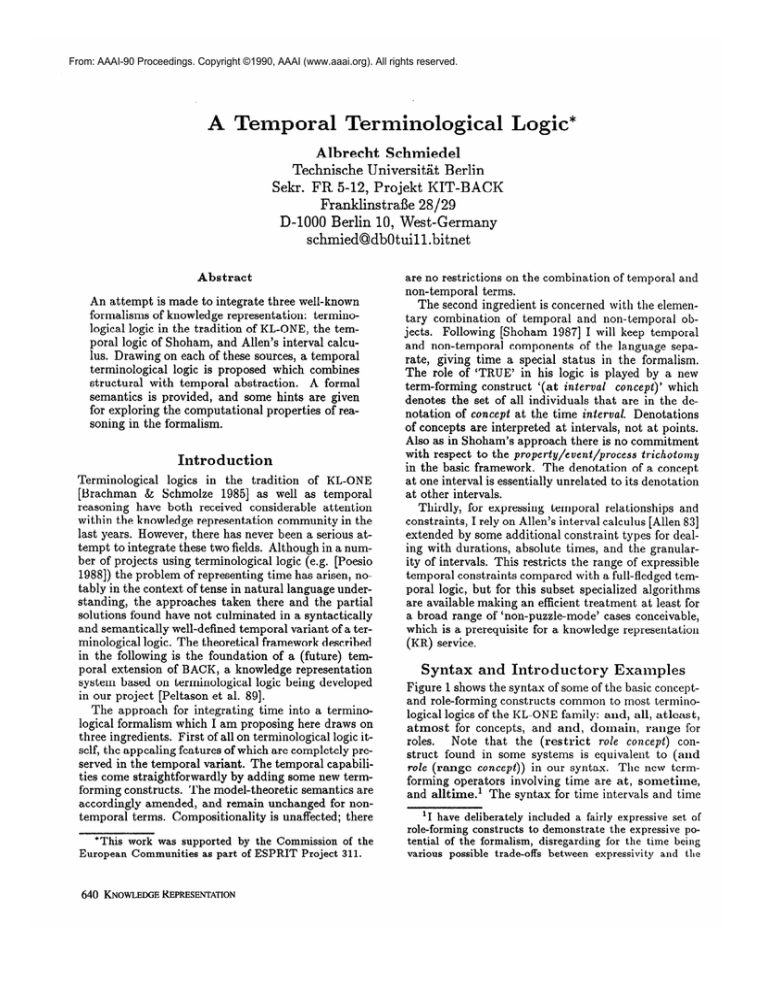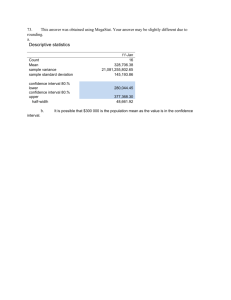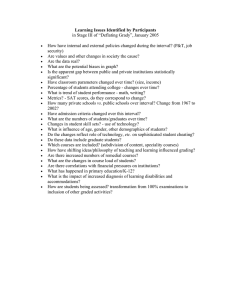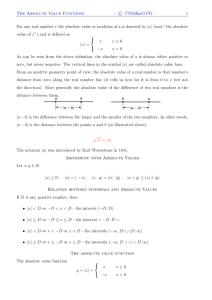
From: AAAI-90 Proceedings. Copyright ©1990, AAAI (www.aaai.org). All rights reserved.
A Temporal
Terminological
Logic*
Albrecht Schmiedel
Technische Universittit Berlin
Sekr. FR 5-12, Projekt KIT-BACK
Franklinstrafle 28/29
D-1000 Berlin 10, West-Germany
schmied@dbOtuill.bitnet
Abstract
An attempt is made to integrate three well-known
formalisms of knowledge representation: terminothe temlogical logic in the tradition of KL-ONE,
poral logic of Shoham, and Allen’s interval calculus. Drawing on each of these sources, a temporal
terminological logic is proposed which combines
structural with temporal abstraction.
A formal
semantics is provided, and some hints are given
for exploring the computational properties of reasoning in the formalism.
Introduction
Terminological
logics in the tradition of KL-ONE
[Brachman & Schmolze 19853 as well as temporal
reasoning have both received considerable attention
within the knowledge representation community in the
last years. However, there has never been a serious attempt to integrate these two fields. Although in a number of projects using terminological logic (e.g. [Poesio
19SS]) the problem of representing time has arisen, notably in the context of tense in natural language understanding, the approaches taken there and the partial
solutions found have not culminated in a syntactically
and semantically well-defined temporal variant of a terminological logic. The theoretical framework described
in the following is the foundation of a (future) temporal extension of BACK, a knowledge representation
system based on terminological logic being developed
in our project [Peltason et al. 891.
The approach for integrating time into a terminological formalism which I am proposing here draws on
three ingredients. First of all on terminological logic itself, the appealing features of which are completely preserved in the temporal variant. The temporal capabilities come straightforwardly by adding some new termforming constructs. The model-theoretic semantics are
accordingly amended, and remain unchanged for nontemporal terms. Compositionality is unaffected; there
*This
European
640
work was supported
by the Commission
Communities
as part of ESPRIT
Project
KNOWLEDGEREPRESENTATION
of the
311.
are no restrictions on the combination of temporal and
non-temporal terms.
The second ingredient is concerned with the elementary combination of temporal and non-temporal objects. Following [Shoham 19871 I will keep temporal
and non-temporal components of the language separate, giving time a special status in the formalism.
The role of ‘TRUE’ in his logic is played by a new
concept)’ which
term-forming construct ‘(at interval
denotes the set of all individuals that are in the denotation of concept at the time interval. Denotations
of concepts are interpreted at intervals, not at points.
Also as in Shoham’s approach there is no commitment
with respect to the property/event/process
trichotomy
in the basic framework. The denotation of a concept
at one interval is essentially unrelated to its denotation
at other intervals.
Thirdly, for expressing temporal relationships and
constraints, I rely on Allen’s interval calculus [Allen 831
extended by some additional constra.int types for dealing with durations, absolute times, and the granularity of intervals. This restricts the range of expressible
temporal constraints compared with a full-fledged temporal logic, but for this subset specialized algorithms
are available making an efficient treatment at least for
a broad range of ‘non-puzzle-mode’ cases conceivable,
which is a prerequisite for a knowledge representation
(KR) service.
Syntax
and Introductory
Examples
Figure 1 shows the syntax of some of the basic conceptand role-forming constructs common to most terminological logics of the KL-ONE family: and, all, atleast,
atmost for concepts, and and, clomain, range for
Note that the (restrict
role concept) conroles.
struct found in some systems is equivalent to (and
role (range concept)) in our syntax. The new termforming operators involving time are at, sometime,
and al1time.l The syntax for time intervals and time
‘1 have deliberately
included a fairly expressive
set of
role-forming
constructs
to demonstrate
the expressive potential of the formalism,
disregarding
for the time being
various possible trade-offs
between
expressivity
and the
concept
role
....-
....-
I
I
I
I
I
I
I
atomic-concept
( and concept+)
( all role concept)
( atleast min role)
( atmost max role)
( at interval concept)
( sometime ( interval-variable+)
time-net concept)
( alltime ( interval-variable+)
time-net concept)
I
I
I
I
I
I
atomic-role
( and role+)
( domain concept)
( range concept)
( at interval role)
( sometime
( interval-variable+)
time-net role)
( alltime ( interval-variable+)
time-net role)
Figure 1: Syntax for Concepts and Roles with Temporal Structure
nets is found in Figure 2.
In standard terminological logics using the nontemporal constructs of the syntax concepts can be
formed such as
(and man
(atleast 1 (and child (range female)))
(all child grown-up)),
with the intuitive
meaning a mun with atleast one
child, which is a female, whose children are all grownup. According to the model-theoretic
semantics for
the term-forming constructs, the extension of a term
is strictly a function of the extensions of its subterms
and of the extensions of the atomic concepts or roles
it contains, in this example the concepts man, female,
grown-up,
and the role child.
An important feature that all KR systems based on
terminological logics provide is the possibility of introducing new atomic concepts and roles by definition, for
example
daughter
:= (and child (range
female)).
After this definition, the new name can be used in other
terms and definitions as an abbreviation for the defining term.
Before looking at some examples using the new constructs involving time, let us consider the meaning of
non-temporal terms. For example, if we define
car-owner
:= (atleast
1 (and own (range car))),
what is the meaning of car-owner within the temporal framework? The answer is that all terms have to
be evaluated with respect to a particular interval of
time. Consequently, car-owner does no more denote a
set of individuals fulfilling the definition, but in fact a
computational
complexity
of classification
algorithms.
I
could also have included negation and disjunction
(as some
terminological
logics do), but that contributes
nothing to
the problem at hand of integrating time.
function that assigns such a set of individuals to evwe can bind the
ery interval. Using the at-construct,
time of evaluation of a term to a specific interval. For
example,
(at ‘August
1990’ car-owner)
denotes the set of car-owners at the interval denoted by
the interval constant ‘August 1990’.
Every term can be rewritten as (at NOW term).
NOW is the special reference interval which represents
the index at which the term is evaluated. Thus, the
index implicit in every non-temporal term can be made
explicit. Every at-term creates an evaluation environment whereby every (explicit and implicit) occurrence
of NOW in the embedded term is bound to the interval specified in the at-term. Taking the last example,
if we expand the definition of car-owner and bind the
implicit NOW’s, we get
(atleast
1 (and
(at ‘August 1990’ own)
(range (at ‘August 1990’ car)))).
Note that the outer at-terms are redundant (and have
therefore been deleted in the example), since there are
no more embedded NOW’s that the time interval could
be bound to.
We can identify two classes of terms: time-indexed
terms whose denotation depends on a particular value
of NOW and universal terms whose denotation is the
same for all values of NOW.
Obviously, all terms
that contain no unbound (implicit or explicit) occurrences of NOW are necessarily universal, and as a consequence an at-term embedding a universal term is
redundant and can be replaced by the term itself.
With the at-construct and temporal constants alone,
expressivity is very restricted. The potential for temporal abstraction comes with the ability to express
abstract temporal patterns, which classify objects in
terms of their pattern of change. In order to achieve
SCHMEDEL
641
time-net
time-constraint
interval-relation
comparison
granularity
interval
interval-variable
interval-constant
duration-constant
::=
I
::=
:I=
........-
time-constraint
( and time-constraint +)
( interval-relation
interval interval)
( comparison interval duration-constant)
( granularity interval)
equal 1before 1after 1meets 1met-by I
overlaps I overlapped-by
I starts I started-by1
finishes I finished-by I during I contains I
( or interval-relation+)
i
I< I= 12 I>
’
set I min I hour 1day I month
::=
: :=
::=
::=
interval-variable
4Ybl---
I year I . . .
I interval-constant
lQlZ2
1x31
I NOW
***
‘1987’ 1 ‘3/12/1987 14:04:12’ I . . .
‘5d 2h 4min 33sec’ I . . .
Figure 2: Syntax for Time Nets
this, temporal variables and means of expressing constraints over these variables are necessary.2 Temporal
variables are introduced by the temporal quantifiers
sometime
and alltime together with a set of constraints, a time net, over these variables. Three kinds
of constraints are allowed by the syntax for time nets
according to Figure 2: relations between pairs of intervals using Allen’s basic interval relations and disjunctions of these, metric constraints on single intervals, and granularity constraints requiring an interval
to take values that are multiples of some time unit.
Absolute bounds can be imposed on an interval by using interval constants in interval relations.
The following term denotes the set of individuals
that were car-owners at an interval sometime before
NOW:
former-car-owner
former-car-owner
temporal role:
former-car-owner
have-owned-a-car
:= (sometime
(x)
(before x NOW)
(at x car-owner)).
can be equivalently expressed using a
:= (atleast
1 have-owned-a-car),
:= (sometime
(x)
(before x NOW)
(at 2
(and own (range
Two individuals are related by have-owned-a-car
car))))).
if they
2The introduction of variables in terms seems counter to
the spirit of KL-ONE-like
languages;
but the only variablefree temporal language I could think of is equivalent to the
subset of the one presented
here where there is only one
variable per sometime- or alltime-term.
That appears
overly restrictive;
not even a covering of NOW by a sequence of meeting intervals can be expressed.
642
KNOWLEDGEREPRESENTATION
were related by own at some interval before NOW and
if at that time the second was an instance of car.
The following term correctly applies to an individual
NOW if at a point during NOW he ceases to be a
car-owner and becomes a bike-owner:
(and (sometime
(x y)
(and (start x NOW)
(finishes NOW y)
(meets x y))
(and (at x car-owner)
(at y bike-owner)))
(alltime (5)
(during x NOW)
(at 2 (atmost 1
(and own (range
vehicle)))))).
It is important to realize that in the sometime-term
there is nothing that expresses ‘ceases to be’ or ‘becomes’; being car-owner and bike-owner at the same
time throughout NOW would be perfectly consistent.
It is only in conjunction with the alltime term, which
restricts the number of role-fillers for the own-a-vehicle
role to atmost one for all times during NOW, and
with the assumption that car and bike are subsumed
by vehicle, that this interpretation is ruled out.
In the previous examples, time nets only used interval relations to constrain temporal variables. The following time net additionally uses metric constraints on
the duration of intervals, and granularity predicates:
(and (day x) (= x ‘24h’)
(day y) (= y ‘24h’)
(meets 2 y)
((or starts finishes during
((or starts finishes during
equal) 2 NOW)
equal) y NOW))
It constrains x and y to be consecutive days within
NOW.
The granularity constraint (day x) above restricts x to take only values that are started and fin-
C[(and cl . . . cn)lt
g[(all r c)]$
E[(atleast m r)]:
4!T[(atmost m r)]=
E[(at 2 c)]:
E[(sometime
X TC
f[(alltime
X TC
([(domain
C[(range
=
ni”=, C[c&
=
=
=
(d E D : E[r]:(d) C C[c]k}
{d E V : IE[r]g(d)l 2 m)
=
c)]”
c)]”
=
c)]:
c)];
=
=
=
v E ‘D : lGw)l
Z(x) if x
E[clF
ifx
G4,
J+‘
(X)
if x
i Glz
L n-4
is a variable
= NOW
is a constant
{d E 2) : 32 E Z*((TC,Xu
(NOW}))jww++t
{d E V : VI E Z*((TC,
X u {NOW}))NOW,+~
E[c]$ x 2)
V x C[c]i
Figure 3: Semantic Conditions for Extension
ished by a day. Without this constraint, x could be
any interval with a duration of 24 hours, due to the
metric constraint (= x ‘24h’), but not necessarily coinciding with a full day of the calendar. On the other
hand, leaving away the duration constraint, x could be
any interval starting and ending with a full day.
Semantics
In terminological logics in the tradition of KL-ONE it
has become customary to provide a model-theoretic
account of the semantics (e.g. [Schmolze 1989, Nebel
19891). I will f o 11ow this tradition. Before spelling out
the semantics for concepts and roles, the semantics associated with temporal constraints must be clarified.
For the present purpose, I will assume a discrete time
model and interpret all time intervals as pairs of integers, and define the domain of time intervals as follows:
7 def {(i&)
1il < ia, il, i2 E Integer}.
Thus, consecutive integers form the smallest, non-decomposable
intervals, the moments in the sense of [Allen & Hayes
19851. For time constraints according to Figure 2, I
will assume a fixed model M which maps interval constants to elements of 7, duration constants to subsets
of 7, comparison operators and interval relations to
sets of pairs of elements of 7, and granularity predicates to subsets of 7, such that the intuitive meaning
of these constructs is adequately mirrored (for example, that (M[‘August 1990’1, M[‘September
1990’1) E
M[meets],
M[‘3/12/1990’] E M[day], etc.).
An interpretation3 of a time net (TC, X), where TC
is a set of constraints and X a set of variables, is a
function Z : X + 7 which satisfies TC (for example,
if (meets x y) E TC, then (Z(x),Z(y)) E M[meets]).
The set of all interpretations of the time net (TC, X) is
denoted by Z*((TC, X)). The set of all interpretations
of a time net in all of which x is mapped to the same
value is denoted by Z*((TC, X)),,,.
A model for a set of terms with temporal structure
defined by the syntax in Figures 1 and 2 is a triple
3The notation
for time
owes much to [NCkel19881.
nets
and
their
interpretations
d E E[c];}
d E $[c];}
Functions
(D, 7, r) where 2) is a set of individuals, 7 is the set
of time intervals, and I is a function
c:
{
“R
---)
(7-+2’D)
+
(7
+
2=y
where C are the concept terms and 1-2 are the role
terms without free variables and after all definitions
have been expanded. Thus, each concept (each role) is
mapped to a function that assigns sets of individuals
(sets of pairs of individuals) to each time interval. For
(D, 7, C) to be a model, the conditions in Figure 34
that define the meaning of the syntactic constructs
must be met for all t E 7.
Taking into account the extension at each time interval, subsumption can now be defined in the usual way:
For all concepts and roles, cl subsumes c2 ifl for all
extension functions
6 (models) and all time intervals
t E 7, tqc2y
E qc1y.
Kinds
of Time
Dependency
As already mentioned in the introduction, in the basic
semantic framework as spelt out in the last section
there are no built-in restrictions on the extensions of
primitive concepts or roles. For example, if a pair of
individuals are related by the primitive role own at one
interval, they may or may not be related by that role
in any subinterval. As a consequence, according to the
semantics so far,
(at ‘June 1990’ own)
does not subsume
(at ‘1990’ own),
and
4Notation:
r(d) dgf {d’ E 2, : (d, d’) E T}, and Z[c]i gf
E(c)(t) where all free variables in c are evaluated using Z.
Note that Z is only needed to evaluate at-terms
nested
within sometime- and alltime-terms.
The conditions for and, at, sometime, and alltime
for
roles have been omitted since they are completely analogous
to those for concepts.
SCHMIEDEL
643
algorithms are available for the temporal variant presented here, but atleast some preliminary hints as to
what is involved can be given. Assume CT’ is of the
form
(sometime
(x)
(> x ‘35 days’)
(at x own))
does not subsume
(and (at ‘June 1990’ own)
(at ‘July 1990’ own)
although intuitively if an own relation holds in an interval it should also be valid in all subintervals, and
if it holds over two consecutive intervals it should
hold over their union (which, in the second example,
is then an interval longer than 35 days). Extra restrictions on extension functions are needed in order
to legitimize the subsumptions above. Using the terminology in [Shoham 19871, the possible extensions
of the primitive role own should be restricted to being downward-hereditary: for all t, t’ E 7, t’ subinterval of t, S[ownlt 2 E[ownlt’, and con&enable:
for
all t, t’, t” E 7, t meets t’, t starts t”, t’ finishes t”,
C[ownlt
fI E[ownlt’
C I[ownlt”.
Of course, for other kinds of concepts and roles these
restrictions are quite inadequate.
For example, for a
role average-temperature
that relates an object to its
average temperature in a certain time interval, the first
subsumption relation above should not hold since average temperatures are not inherited to subintervals; the
second may be correct though, because if an average
remains identical for two consecutive intervals also applies for their union. The latter is certainly not true for
other aggregate values which depend on time, such as
e.g. sales of a department per month, or annual salary
of an employee. For these, another kind of restriction might be more appropiate: a role sales-per-month,
for example, should take values only for intervals that
correspond to full months, and be empty for all other
intervals.
How can these different kinds of restrictions be integrated into our framework? The situation is quite similar to the problem of integrating disjointness restrictions into terminological logics. Should the disjointness of e.g. male and female be treated as definitional
and hence be used for validating certain subsumptions,
or rather as assertional?
On pragmatic grounds, the
former alternative is generally chosen. Terminological systems allow disjointness restrictions for primitive
concepts and use these for computing subsumption.
The same approach could be adopted for restrictions
on temporal extensions of primitive concepts or roles.
So, in the example above, after declaring the primitive role own as downward-hereditary and concatenable, the subsumptions would be valid.
Computing
Subsumption
Subsumption is the central semantic notion in terminological logics; designing sound (and possibly complete)
algorithms that compute subsumption is the central issue for providing practical KR services. Until now, no
644
KNOWLEDGE&PRESENTATION
(sometime
X’ TC’ (and
. . . (at xi ci) . . . )),
j E J, xj E X’ , C: E C’
and CT is of the form
(sometime
X TC (and
. . . (at xi ci) . . . )),
i E I, xi E x, ci E c.
Under what conditions does CT’ subsume5 CT? Intuitively, CT’ is a more general concept than CT, if its
temporal variables are less constrained than those of
CT, and for each of its temporal variables there is a
corresponding variable in CT such that the associated
concept of that variable subsumes the associated concept in CT. Obviously, CT can have additional temporal variables and associated concepts, which specialize
it further.
To formalize this notion, let S : J -+ 1 be a function
from indices of CT’ to indices of CT. Sx : X’ --f X is
defined as Sx(xi) = xs(j), and SC : C’ -+ C is defined
to NOW,
as SC(C[i) = CS(j)e S must always map NOTE
i.e. Sx(NOW) = NOW.
The notion of ‘less constrained temporal variables’
is captured by the following definition: A time net
(TC’,X’)
subsumes another time net (TC, X) wrt a
variable mapping Sx : X’ --+ X iff for all Z E
X’)) such
Z*((TC,
X)) th ere exists an Z’ E P((TC’,
that for all x E X’, Z’(x) = Z(Sx(x)).
We can now express the condition above more formally: CT’ subsumes CT iff there exists a mapping
S : J --+ I such that (TC’, X’) subsumes (TC, X)
wrt Sx, and c; subsumes SC(C$). The subsumption
of time nets guarantees that for every interpretation
of TC there is a corresponding interpretation of TC’,
and the second condition states that for each iuterva.1
of that interpretation the corresponding concepts are
in the subsurnption relation. Tllus, all instan& of CT
must also be instances of CT’.
Assuming for the moment that the ci and ci are
all non-temporal concepts and WC can therefore a.pply known subsumption algorithms, we are left with
the problem of determining subsumption between two
time nets.
Here we can utilize known algorithms
for constraint propagation in temporal networks (e.g.
[Schmiedel 1988, ValdCz-Perez 19871).
These algorithms compute the most specific constraints derivable from the given ones, and at the same time
check whether the network is consistent.
Subsumption can easily be checked-modulo
incompleteness of
constraint propagation-relative
to a given variable
mapping. All constraints in the subsuming network
the ma.pping-in
must have corresponding ones-via
the subsumed network wh ich are at least as restrictive.
5Additional
restrictions
are not taken into account
as mentioned in the last section
in the following.
Conclusion
Of course complete and tractable subsumption algorithms for the whole language and for the standard semantics presented here cannot be expected. In Allen’s
interval calculus on its own, which is a subset of our
temporal constraint language, determining all consequences of a set of constraints is NP-hard [Vilain &
Kautz 19861. And even for moderately expressive languages the non-temporal part is intractable [Nebel
19881. That does not render these formalisms useless. On the one hand, it remains to be seen to what
extent normal cases in practical applications can be
handled even by complete algorithms.
On the other
hand, algorithms for computing subsumption in terminological logics that are incomplete with respect to
standard semantics are increasingly being characterized as complete with respect to a weakened semantics
[Schild 1989, Patel-Schneider 19881; approximative algorithms are also studied in the field of temporal reasoning [van Beek 19891. These developments are a reasonable starting point for developing subsumption algorithms for temporal terminological logics.
References
[Allen 831 James F. Allen, Maintaining
Knowledge
About Temporal Intervals, Communications
of
the ACM 26(11), 832-843, 1983.
System Revisited, KIT Report 75, Fachbereich Informatik, Technische Universitat Berlin, 1989.
[Poesio 19881 Massimo Poesio, Towards a IIybrid Representation of Time, Proc. ECAI-88,
Munich,
1988.
[Schild 19891 Kl aus Schild, Towards a Theory of
Frames and Rules, KIT Report 76, Fachbereich
Informatik, Technische Universitat Berlin, 1989.
[Schmolze 19891 J ames G. Schmolze, The Language
and Semantics of NIKL, Technical Report 894,Tufts University, Medford (Mass.), September
1989.
[Schmiedel 19881 Albrecht Schmiedel, Temporal Constraint Networks, KIT Report 69, Fachbereich Informatik, Technische Universitat Berlin, 1988.
[Shoham 19871 Yoav Shoham, Temporal Logics in AI:
Semantical and Ontological Considerations, Arlificial Intelligence 33(l), 89-104, 1987.
[Vilain & Kautz 19861 M arc B. Vilain, IIcnry Kautz,
Constraint Propagation Algorithms for Temporal
Reasoning, Proc. AAAI-86, Phila.delphia (Penn.),
377-382, 1986
[Valdez-Perez 19871 Ratil E. Valdkz-Perez 87, The Satisfiability of Temporal Constraint Networks, Proc.
AAAI-87,
Seattle (Wash.), 256-260, 1987.
[Allen & Hayes 19851 James
F. Allen,
Patrick
J.
Hayes, A Common-Sense Theory of Time, Proc.
9th IJCAI, Los Angeles (Cal.), 528-531, 1985.
[van Beek 19891 P e t er van Beek, Approximation Algorithms for Temporal Reasoning, Proc. 11th IJCAI, Detroit (Mich.), 1291-1296, 1989.
[Brachman & Schmolze 19851 Ronald
J. Brachman
and James G. Schmolze, An overview of the KLONE knowledge representation system, Cognitive
Science 9(2), 171-216, 1985.
[Nebel 19881 Bernhard Nebel,
plexity of Terminological
Artijicial
Intelligence
Computational
ComReasoning in BACK,
34, 371-383,
1988.
[Nebel 19891 Bernhard Nebel, Reasoning and Revision
in Hybrid Representation Systems, Ph. D. Thesis,
UniversitZt des Saarlandes, Saarbriicken, 1989. To
appear in Lecture Notes in Artificial Intelligence,
Springer, Berlin.
[Niikel 19881 Kl aus Nijkel, Convex Relations Between
Time Intervals, SEKI Report SR-88-17, Universit%t Kaiserslautern, 1988.
[Patel-Schneider 19881 Peter
F.
Patel-Schneider,
Adding Number Restrictions
to a Four-Valued
Terminological Logic, Proc. AAAI-88, Saint Paul
(Minn.), 485-490, 1988.
[Peltason et al. 891
Christof Peltason, Albrecht Schmiedel, Carsten
Kindermann, and Joachim Quantz, The BACK
SCHMIEDEL
645




